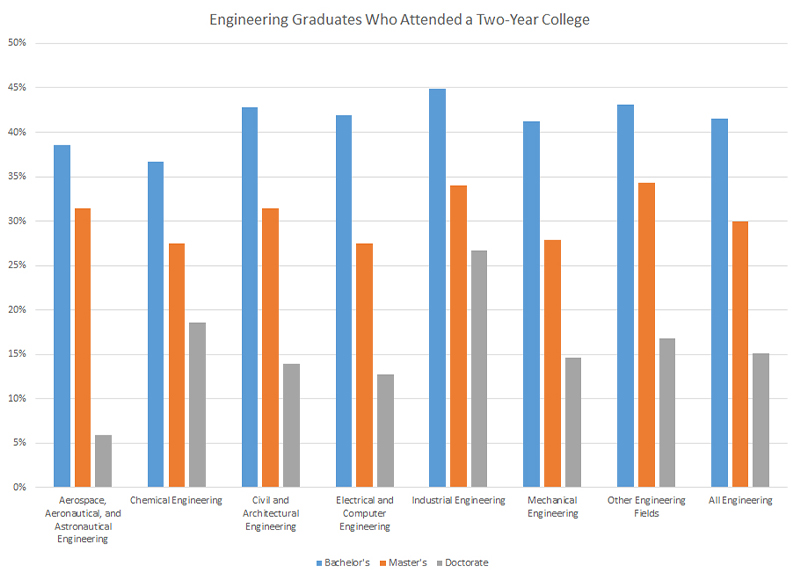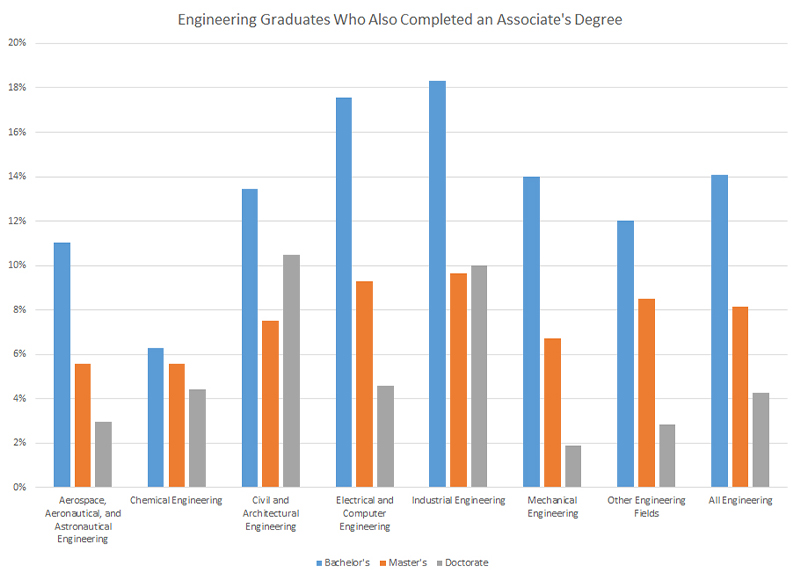MANY ENGINEERING GRADS START OUT AT TWO-YEAR COLLEGES
By Carolyn Wilson
Reprinted from ASEE Connections
Over the past few years, at least 17 states have established tuition-free programs for students to attend an in-state two-year college. This trend represents an effort to open doors to postsecondary education and workforce training for students from low- or middle-income families1. As more states enact such programs across the country, we may see a surge in enrollment at two-year colleges. In 2017, nearly 6 million students enrolled in two-year colleges. Of these, 14% were Black/African American, 36% were Hispanic, 0.3% were Native Hawaiian/Pacific Islander, and 1% were Native American/Native Alaskan2. Two-year colleges tend to have a more diverse student population than four-year universities due to lower costs and locations close to where students live. Many four-year universities, in a bid to increase diversity, have created partnerships and pathways for two-year college students to transfer into bachelor’s degree programs.
Within the science and engineering workforce, approximately 47% of terminal bachelor’s graduates, 40% of terminal Master’s graduates, and 22% of Doctoral graduates spent a portion of their postsecondary education at a two-year college, according to 2017 data from the National Science Foundation’s National Survey of College Graduates3. Among engineering graduates, 42% of terminal bachelor’s graduates, 30% of terminal Master’s graduates, and 15% of doctoral graduates attended a two-year college. Graduates with an industrial engineering degree had the highest percentages of attendance at two-year colleges at all degree levels compared with other major engineering fields.
While close to half of the science and engineering workforce with bachelor’s and Master’s degrees attended a two-year college, 19% of terminal bachelor’s graduates, 13% of terminal Master’s graduates, and 6% of doctoral graduates earned an associate’s degree before transferring to a four-year university. Among engineering graduates, 14% of terminal bachelor’s graduates, 8% of terminal Master’s graduates, and 4% of doctoral graduates earned an associate’s degree. Graduates with an industrial engineering degree had the highest percentages of earned associates’ degrees at all degree levels compared with other major engineering fields.
Carolyn Wilson is a senior research associate in ASEE’s Institutional Research & Analytics Department.
1U.S. News and World Report, September 19, 2018. 17 States Offer Tuition-Free College Programs. https://www.usnews.com/education/best-colleges/paying-for-college/articles/2018-02-01/these-states-offer-tuition-free-college-programs
2Department of Education’s National Center for Education Statistics, 2018, Table 306.20. https://nces.ed.gov/programs/digest/2017menu_tables.asp
3NSF’s National Survey of College Graduates. https://www.nsf.gov/statistics/srvygrads/


